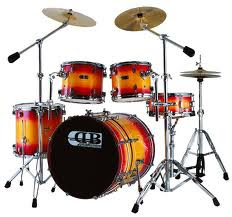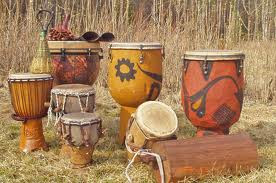the bass drums are of variable sizes and are used in several musical genres (see usage below). Three major types of bass drums can be distinguishe The type usually seen or heard in orchestral, ensemble or concert band music is the orchestral, or concert bass drum (in Italian: gran cassa, gran tamburo). It is the largest drum of the orchestra. The 'kick' drum, struck with a beater attached to a pedal, is usually seen on drum kits. The third type, the pitched bass drum, is generally used in marching bands and drum corps. This particular type of drum is tuned to a specific pitch and is usually played in a set of three to five drums. The bass drum was imported from the Middle East.
In music, the bass drum is used to mark or keep time. In marches it is used to project tempo (marching bands historically march to the beat of the bass). A basic beat for rock and roll has the bass drum played on the first and third beats of a bars of common time, with the snare drum on the second and fourth beats, called "back beats". In jazz, the bass drum can vary from almost entirely being a timekeeping medium to being a melodic voice in conjunction with the other parts of the set. In classical music, the bass drum often punctuates a musical impact, although it has other valid uses, depending on the size, and how and where the drum is struck. Implements used to strike the drum may include bass drum beaters of various sizes, shapes, and densities, as well as keyboard percussion mallets, timpani mallets, and drumsticks. The hand or fingers can also be used (it. con la mano). The playing techniques possible includes rolls, repetitions and unison strokes. Bass drums can sometimes be used for sound effects. e.g. thunder, or an earthquake
AFRICAN DRUM
The majority of African music relies heavily on the playing of drums. It is also characterized by an intense rhythmic playing style. This style of fast-paced, upbeat rhythmic drum playing can be found in many of the drum playing of tribes all over the continent of Africa. It is especially true of the people and tribes of Western Africa. However, there are music styles that do not rely so heavily of on the use of the drum, such as Township music, which is prevalent in South Africa. The uses of the drum music are not limited to entertainment and dance, however. In many tribes, they serve a purpose to the local community and help in the conduct of daily routines. The beats and sounds of the drum are used in communication, as well as cultural expression[1]
Many aspects of African drumming, most notably time-keeping, stem from instruments not categorized as membranophones. Items such as shakers made of woven baskets, shakers made of gourds, and rattles along with the standard African double-bell were used to organize a musical event. Each region of Africa developed a different style of double-bell. Made of iron and creating two different tones, double-bells are the time keepers of African drumming
DOUBLE-BASS DRUM



No comments:
Post a Comment